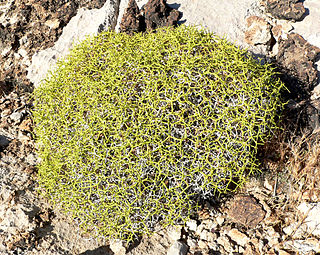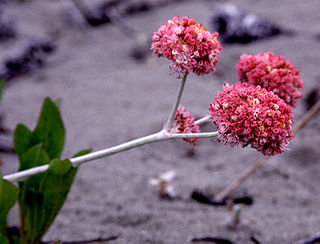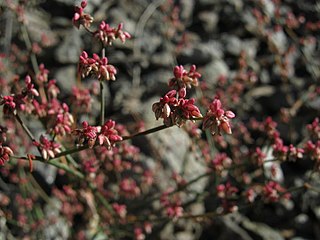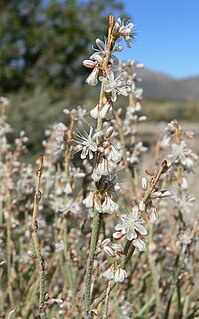
Eriogonum deflexum is a species of wild buckwheat known by the common names flatcrown buckwheat, flat-top buckwheat, and skeletonweed. This plant is native to the southwestern United States and northwestern Mexico, where it is common and grows in a variety of habitats, especially desert scrub. It is somewhat weedy where it is most abundant. This is an annual which varies in size from small patches on the ground to tangled bushes approaching two meters in height; it may be dense or thin and spindly. This is a brown or greenish weedy-looking herb with a many-branched stem. The leaves are located at the base of the plant and are rounded and woolly and one to four centimeters long. Small clusters of flowers appear at intervals along the branches with each flower only one to three millimeters wide and white or pinkish in color.

Eriogonum elatum is a species of wild buckwheat known by the common name tall woolly buckwheat. It is native to the western United States from California to Idaho. It is a perennial herb varying in size from one half to 1.5 meters in height. Its long leaves are located at the base of the plant and can be quite long for a buckwheat, over 20 centimeters in maximum length. The erect, branching stems are thin and naked and occasionally hollow. The plant produces small to large inflorescences with clusters of tiny flowers in shades of white to dark pink.

Eriogonum gracillimum is a species of wild buckwheat known by the common name rose and white buckwheat. It is endemic to California but is common and widespread in many areas there. This is a spindly annual herb reaching anywhere from 5 to 50 centimeters in height. Most of the leaves are basal with a few scattered on the thin branched stem and are generally one to four centimeters long and somewhat woolly, with edges rolled under. Along the thread-thin branches of the stem appear small clusters of flowers which hang on short stalks in bell-shaped involucres. The two-millimeter-wide flowers are bright rose and white in color.

Eriogonum heermannii is a species of wild buckwheat known by the common name Heermann's buckwheat. It is native to the southwestern United States from California to Utah where it grows on rocky slopes, desert flats, and dry washes.
Eriogonum intrafractum is a species of wild buckwheat known by the common names jointed buckwheat and napkinring. This plant is endemic to Inyo County, California, where it is known only from the mountain ranges surrounding Death Valley. It is an uncommon, distinctive perennial herb which grows in scattered patches on rocky limestone soils in these desert mountains.

Eriogonum latifolium is a species of wild buckwheat known by the common names seaside buckwheat and coast buckwheat. This plant is native to the coastline of the western United States from Washington to central California, where it is a common resident of coastal bluffs and scrub.

Eriogonum lobbii is a species of wild buckwheat known by the common name Lobb's buckwheat or prostrate buckwheat. It is native to most of the mountain ranges of northern California and their extensions into Oregon and Nevada. It is found in a number of mountain plant communities.

Eriogonum maculatum is a species of wild buckwheat known by the common name spotted buckwheat. It is native to western North America from Washington to Baja California to Utah, where it can be found in a number of habitats, often in abundance.

Eriogonum nummulare is a species of wild buckwheat known by the common names Kearney's buckwheat and money buckwheat. It is native to the Great Basin of the United States from California to Utah, where it grows on sandy slopes and plateaus.

Eriogonum wrightii is a species of wild buckwheat known by the common names bastardsage and Wright's buckwheat. It is native to the Southwestern United States, California, and northwest Mexico, where it grows in many plant communities, such as chaparral, in rocky habitats from mountains to deserts.

Eriogonum angulosum is a species of wild buckwheat known by the common name anglestem buckwheat.
Eriogonum argillosum is a species of wild buckwheat known by the common names clay buckwheat, clay-loving buckwheat, and Coast Range wild buckwheat. It is endemic to California, where it is known only from San Benito and Monterey Counties. It grows on clay substrates, often of serpentine origin. This is an annual herb up to 30 to 60 centimeters tall with a basal patch of oval-shaped, woolly leaves and a naked stem. The top of the stem is occupied by the inflorescence, a cyme with several clusters of tiny white or pink flowers.

Eriogonum cithariforme is a species of wild buckwheat known by the common name cithara buckwheat.
Eriogonum gossypinum is an uncommon species of wild buckwheat known by the common name cottony buckwheat. It is endemic to California, where it is known from the southern Central Valley and some of the adjacent foothills. It is often found on clay soils. It is an annual herb producing a gray or reddish branched stem no more than about 20 centimeters tall. The leaves are oblong in shape and woolly in texture. The scattered inflorescences are small clusters of white to pink glandular flowers buried in a layer of cottony fibers.

Eriogonum gracile is a species of wild buckwheat known by the common name slender woolly buckwheat.

Eriogonum hoffmannii is a species of wild buckwheat known by the common name Hoffmann's buckwheat. It is endemic to Inyo County, California, where it is found only in the mountains around Death Valley; most of the known populations of the plant are located in Death Valley National Park. The plant grows in the desert scrub on the slopes of the Panamint, Black, and Funeral Mountains.

Eriogonum luteolum is a species of wild buckwheat known by the common name goldencarpet buckwheat. It is native to many of the mountain ranges of California and southern Oregon, including the Sierra Nevada, Cascades and California Coast Ranges. It grows in mountain and foothill habitat, such as forest and woodland, on granite and sometimes serpentine soils.
Eriogonum molestum is a species of wild buckwheat known by the common name pineland buckwheat. It is endemic to southern California, where it grows in the Transverse Ranges of Ventura County to the Peninsular Ranges of San Diego County.

Eriogonum panamintense is a species of wild buckwheat known by the common name Panamint Mountain buckwheat. It is native to several of the desert mountain ranges of eastern California and western Nevada, including the Panamint Range. It grows in various types of mountain ridge habitat, such as sagebrush and coniferous woodland.

Eriogonum viridescens is a species of wild buckwheat known by the common name twotooth buckwheat. It is endemic to California, where it grows in the Central Coast Ranges through the Transverse Ranges and into the Mojave Desert, as well as in the Central Valley. It grows in a variety of habitat types, generally on clay and sandy soils.















